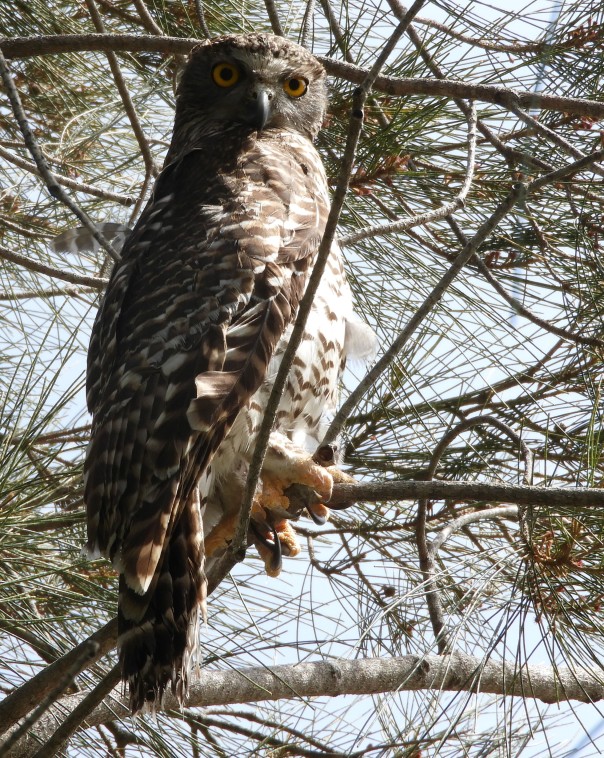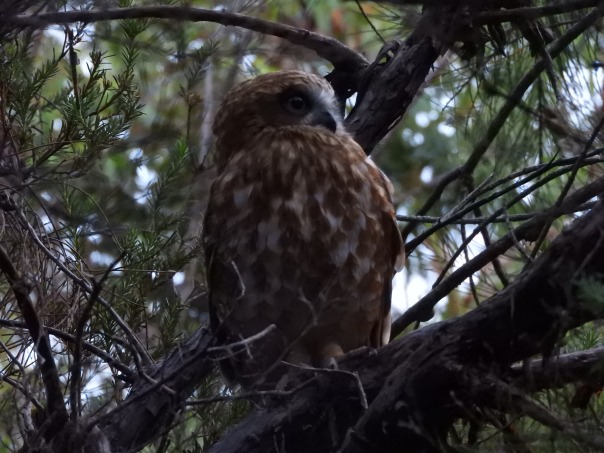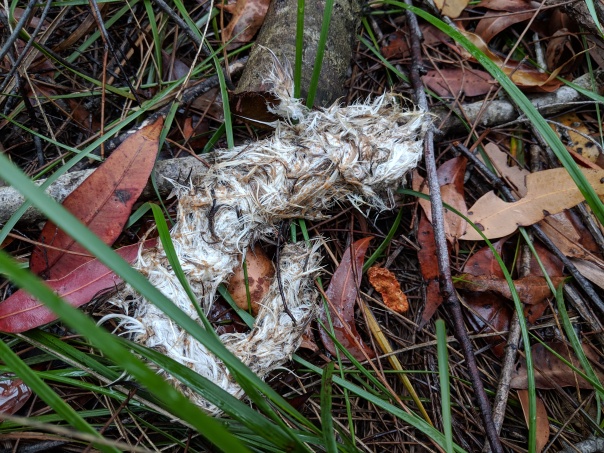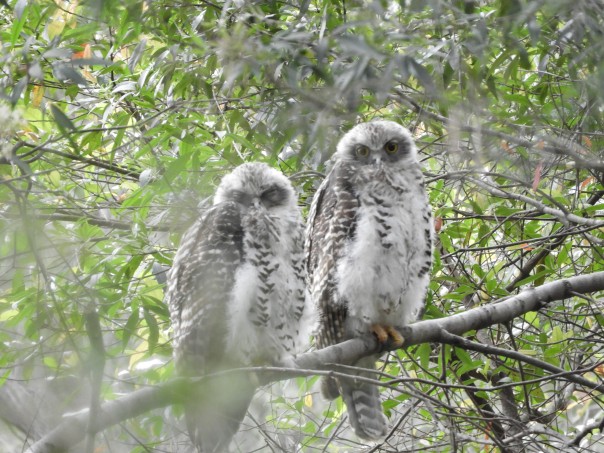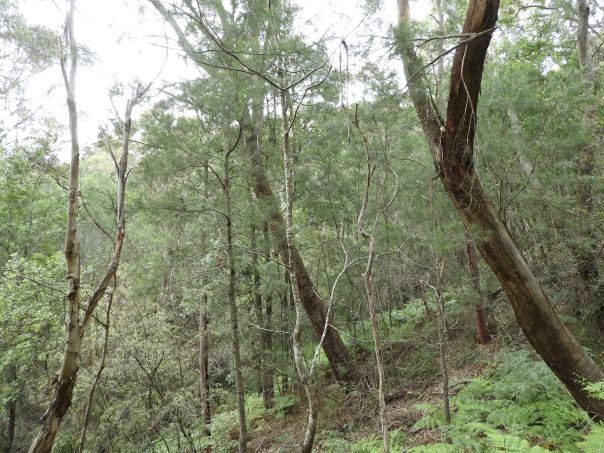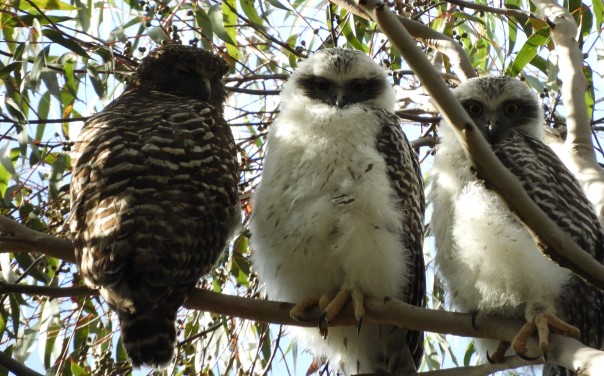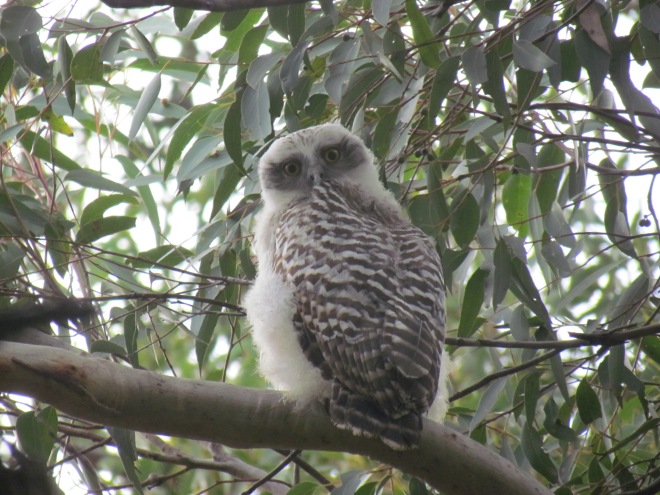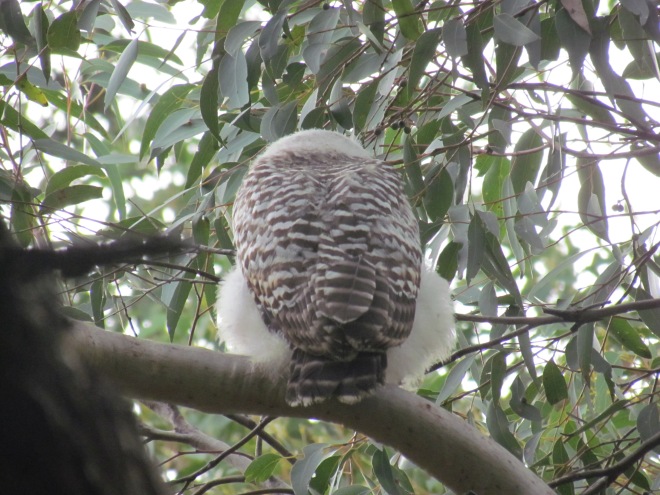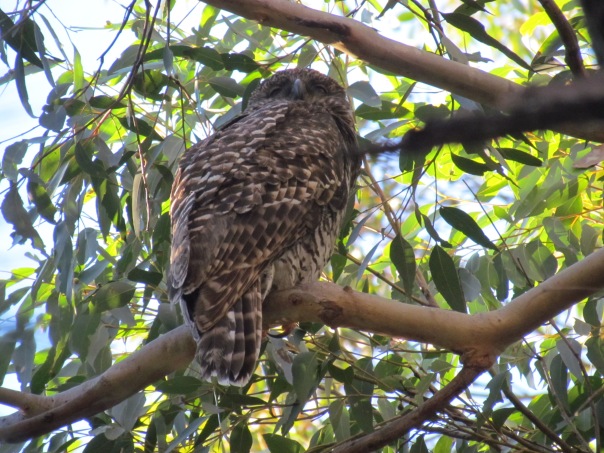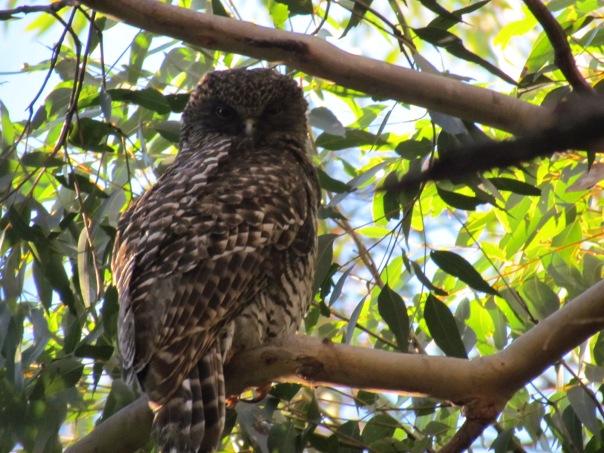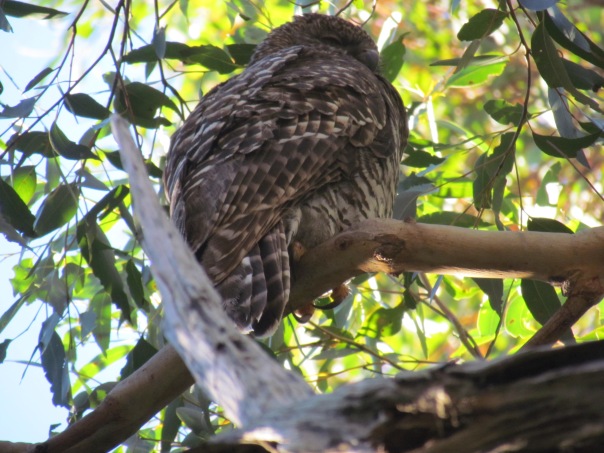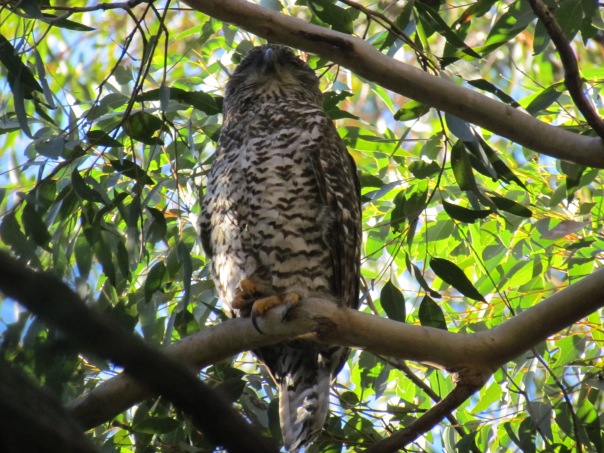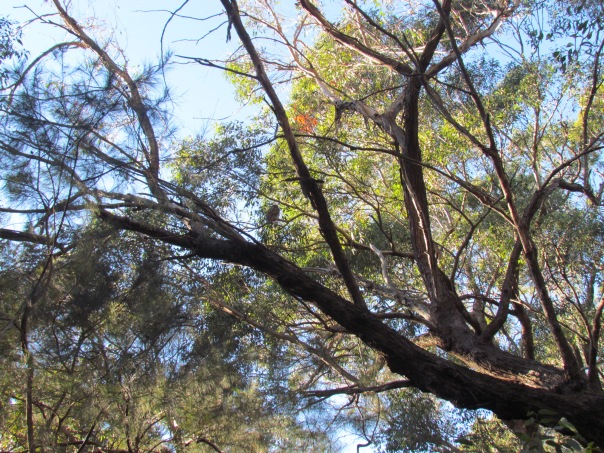Category Archives: Owl
Triangle of power: Three Powerful Owls
High, high in the trees perched three of Australia’s biggest owls: Powerful Owls:

I used the super zoom on my camera to see one of the birds up close. It knew I was there! What big eyes:

Powerful Owls eat small creatures, including possums. The birds can weigh well over 2 kilograms, and reach up to 65 centimetres in height. Look at those huge feet and strong claws. Like all owls, the birds hunt at night and roost quietly during the day.
Common name: Powerful Owl
Scientific name: Ninox strenua
Approximate length: 65 cm
Date spotted: 6 December 2020 (summer)
Location: Manly Dam Park, New South Wales, Australia. (Approximate map reference: 33°46’55.8″S 151°15’12.1″E)
Rescued a Powerful Owl from Australian Ravens
As I was walking in the bush this morning, I heard a lot of noise coming from an open space just off the track. Currawongs chiming, ravens yowling, miners bleating. I went to investigate, and found a Powerful Owl under attack.
Here’s the Powerful Owl, looking decidedly jaded after facing off the most recent jabs from a couple of Australian Ravens:
The Australian Miners and Currawongs were making a lot of noise, and even a couple of kookaburras swooped in to join the fight. But the principal attackers were the Australian Ravens.
At first, the Powerful Owl was able to fend off the attack:
But the ravens were pretty vicious. The owl was high in the tree at this point, and there was nothing I could do to scare off the attackers.
I phoned the Manly Dam bush ranger centre and reported the problem. A ranger promised to come immediately. In the meantime, the owl was suffering and it was distressing not to be able to help:
At last, the owl ceded ground and flew to a lower spot in the tree:
At the same time, the attacks became more vicious, with the ravens grabbing both wings and pulling at the same time, stretching out the owl’s wings.
The owl was at this point only about 2.5 metres above the ground. A jogger came rushing in to help, and together she and I were able to scare off the ravens and other attackers.
The bush ranger arrived soon afterwards. After a bit of discussion, we decided the best thing was to phone WIRES for advice. WIRES is the Australian Wildlife Information, Rescue and Education Service.
In the meantime, we had to keep chasing away the ravens. They were extremely persistent, returning every few minutes to see if the coast was clear for another attack. The owl looked on, more relaxed than when under attack, but still alert:
Common name: Powerful Owl
Scientific name: Ninox strenua
Approximate length: 65 cm
Date spotted: 7 October 2019 (spring)
Location: Manly Dam National Park, New South Wales, Australia: 33°46’55.8″S 151°15’12.1″E
The advice from WIRES was to leave the owl where it was (don’t try to scare it into flying away) and to keep chasing away the ravens. Evidently Powerful Owls tend to stay in one place during the day, even when under attack. Besides which, the jogger had seen the owl flying from one tree to another earlier that morning, with the ravens dive-bombing it in flight. So flying off was probably not a good option anyway.
So we kept chasing away the ravens. After a couple of hours, two families arrived and settled in for a day of boating and picnicking. We handed over the job of raven-scaring to them, and the bush ranger said she would drop by every couple of hours to check up on the owl.
Not a restful day for this nocturnal bird. But at least this is one case where it was a good thing for the bird that people were around. I do hope the Powerful Owl had a more peaceful time for the rest of the day.
Wakeful Southern Boobook at Manly Dam
A little Southern Boobook was wide awake when I walked beneath its tree this morning. This is the first time I’ve seen one of these owls, though I’ve heard them hoot during the night hours.
I sat down on the ground and watched the bird for a while. It wasn’t disturbed by my presence, and grew quite sleepy, as you can see in the next video. At the end of the video I zoomed out so that you can see a bit of the bush surrounding the bird:
Southern Boobooks are quite small, at around 30cm in length from head to tail. Compare that to the Powerful Owl, which is around 65cm.
Here’s a still photo of the bird, showing a deep yellow eye and fluffy white feathers above its beak:
Southern Boobooks are quite common. They feed mostly on insects and spiders, but they do take the occasional small bird or animal too. Here’s a closeup of the owl’s face:
Common name: Southern Boobook
Scientific name: Ninox novaeseelandiae
Approximate length: 30cm
Date spotted: 20 March 2019 (late summer)
Location: Manly Dam National Reserve, near Sydney: 33°46’30.0″S 151°15’09.2″E
Powerful Owl pellet, also known as owl vomit or regurgitation
This morning I came across this weird-looking bundle of hair and stuff in the bush surrounding Manly Dam National Park near Sydney:
Date spotted: 20 January 2019 (Summer)
Location: Manly Dam National Park, New South Wales, Australia: 33°46’24.5″S 151°15’04.4″E
At first I thought it was some weird creature, but it had no visible eyes and didn’t really look alive, although it was obviously animal in nature. I picked up a stick and turned the object over gently. It didn’t try to move away. Definitely not alive. It looked the same on both sides. No obvious undercarriage.
So then I thought, maybe it’s some dead creature that’s become covered in a thick fungus. It’s summer here in Sydney—hot, humid, lots of fungus on the trees and mould on animal poo in the forest. In fact, I’ve seen animal poo that’s completely white and fuzzy, with long tendrils of mould standing up straight.
Still, the fungus idea didn’t quite fit the bill. The stuff covering this object looked more like fur than fungus.
So I took a photo and moved on.
When I got home and showed my husband the photo of this weird thing I’d seen, he suggested it might be owl’s vomit. They do that, he said. They regurgitate fur and stuff. So I looked it up. Indeed they do.
The official name for owl vomit is owl pellet. I think this one must be from a Powerful Owl (Ninox strenua), because I’ve seen those birds in the same area of the bush before, and because this pellet was big. It was around 6 inches long (15 cm) and 2 inches (5 cm) at its widest.
Here’s a Powerful Owl that I saw a while ago, also at Manly Dam. This owl has its prey (a dead possum) in its grip:
An owl’s pellet consists of fur, bones, and other bits and pieces of its prey that the owl can’t digest. An owl needs to regurgitate a pellet once or twice every night, six hours or more after the owl has eaten.
If you like, you can see more about the Powerful Owls I’ve seen around Manly Dam.
Growing up – juvenile Powerful Owls near Sydney
Two months ago I spotted a family of Powerful Owls in Manly Dam National Park, near Sydney. Last week I spotted two of them again in the same area of bush. Given their fluffiness, I think these are the two juveniles of the family.
This is what the scene looked like without my camera’s powerful 60x zoom. If you look carefully, you can just make out the two owl-shaped dots in the centre of the picture:
Below is a closer view. It seems to be usual for one bird to be awake and vigilant while the other sleeps:
In this video, the awake owl blinks a slow, wise blink and wiggles its head from side to side in that endearing yet terrifying manner they have. A little later, the call of a passing Currawong attracts the owl’s attention:
Common name: Powerful Owl
Scientific name: Ninox strenua
Approximate length: 65 cm
Date spotted: 25 November 2018 (Spring)
Location: Manly Dam Reserve, New South Wales, Australia
Family of Powerful Owls
Powerful Owls are magnificent birds. When you come across them in the bush, your first impression is of their size. They are huge. Next, you notice how cute and fluffy they seem. And how watchful.
The two birds with white fluffy chest feathers are juveniles. Adults have dark chevron markings on their fronts, as you can see in the bird on the lowest branch in this shot. I think the lowest bird is the father, as he is significantly bigger than the other adult.
This video shows an amusing scene of the two juveniles spotting something at the same time, and moving their heads in sync:
Powerful Owls are listed as uncommon in my bird book. They’re also sedentary, which means they don’t migrate or move to different areas at different times of the year.
All four owls were awake and watchful, even though this was their sleeping time. They watched me for a while, from their roost high in the treetops.
Eventually they decided I was harmless, probably since I didn’t seem to be able to fly.
The biggest bird is at bottom left of this shot, and I think this bird is the male of the family. In this next video, he decided to move (nudged by a call of nature, it turns out) which gives you a good view of his feet:
In the next video, the two adults are doing a bit of grooming. The raucous calls of a Sulphur-crested Cockatoo startle the juveniles, but the adults are obviously used to their noisy neighbours:
The next shot shows how high up they were, and how large in relation to the big gum trees that form their habitat:
Here’s another shot showing the two babies and the smaller of the adults (the mother, I think):
Common name: Powerful Owl
Scientific name: Ninox strenua
Approximate length: 65 cm
Date spotted: 22 September 2018 (Spring)
Location: Manly Dam Reserve, New South Wales, Australia
Juvenile Powerful Owl with two adults
Today I went back to a spot in the bush where I’ve seen a Powerful Owl a few times. This time, there were three owls, one of them a juvenile: white and fluffy, with dark patches around its eyes. It heard me, and checked me out:
It’s hard to get a good day’s sleep when you’re an owl. Listen to all the noise they have to put up with from the other birds:
Here’s a still photo of the three owls:
And here’s a rear view of the juvenile:
Common name: Powerful Owl
Scientific name: Ninox strenua
Approximate length: 65 cm
Date spotted: 6 October 2014
Season: Spring
Location: Manly Dam National Park, New South Wales, Australia
Latitude/longitude: 33°46’51.0″S 151°14’52.1″E
Powerful Owl and its dinner
A few weeks ago I spotted a Powerful Owl roosting high on a branch in Manly Dam Reserve. (Blogged.) I’ve seen the bird in exactly the same spot a couple of times since then.
The owl was there again today, so I snapped a few shots. Only when I looked at the photos on my computer did I spot the poor little possum (already demised) that is grasped in the owl’s claws.
Common name: Powerful Owl
Scientific name: Ninox strenua
Approximate length: 65 cm
Date spotted: 14 September 2014
Season: Spring
Location: Manly Dam National Park, New South Wales, Australia
Approximate latitude/longitude: 33°46’50.2″S 151°14’54.5″E
Powerful Owl roosting
While walking through the bush this morning, I spotted some tell-tale white splatters on the ferns lining the path. I looked up into the trees, and sure enough there was a Powerful Owl high above my head.
The zoom in this short video shows how high up the owl was. You’ll also hear the kookaburras laughing and a couple of cockatoos scolding. The owl doesn’t do much except swivel its head.
Here’s a still shot of the owl gazing into the distance:
Spotted!
Still watching…
Dozing:
A view from the front:
And the view of the owl without my camera’s super zoom:
Common name: Powerful Owl
Scientific name: Ninox strenua
Approximate length: 65 cm
Date spotted: 27 July 2014
Season: Winter
Location: Manly Dam National Park, New South Wales, Australia
Approximate latitude/longitude: 33°46’50.2″S 151°14’54.5″E




